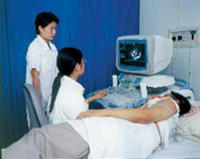Is diabetes hereditary?
My father's diabetes was diagnosed in his sixties. I fear that one day I'll become a diabetic too, in my later life. Is there anything I can do to prevent this?
Diabetes often runs in families. If one of your parents has diabetes, your chances of getting it immediately become significantly higher.
Certain population groups are also more prone to this condition, as are people who are significantly overweight.
But if you are diabetic, it is by no means certain that your children will also be diabetics. Just as they may not have inherited your curly hair or strong teeth, they may also have sidestepped the diabetes.
Diabetes occurs in two forms;
· type 1 diabetes (insulin-dependent diabetes), which occurs in young people and is the more severe form, requiring insulin injections
· type 2 diabetes (non-insulin dependent diabetes), which is milder and occurs in older people and is usually controlled with diet and tablets.
There are the obvious factors to reduce your risk of also becoming diabetic such as watching and controlling the foods you eat, particularly ones that contain a lot of sugar. 60 is quite old to have diabetes, I don't know how old you are but I wouldn't worry about it for quite a while yet.Don't forget you also have your mum's genes as well, so you may never become diabetic.
What is the level of high blood suger? And what should I pay attention in daily life?
I want to know what level is the high blood suger and what diet should I follow .
A diabetes diet — medically known as medical nutrition therapy (MNT) for diabetes — simply translates into eating a variety of nutritious foods in moderate amounts and sticking to regular mealtimes.
Rather than a restrictive diet, a diabetes diet or MNT is a healthy-eating plan that's naturally rich in nutrients and low in fat and calories, with an emphasis on fruits, vegetables and whole grains. In fact, a diabetes diet is the best eating plan for most everyone
The normal blood suger before meal is between 3.9—6.1. If the suger has been more than 7.0, then you have to pay attention to the diabetes.
Oatmeal
Oatmeal can help control blood sugar -- but don't get the sweetened kind.
Broccoli, Spinach, and Green Beans
Add plenty of nonstarchy vegetables, such as broccoli, spinach, and green beans, to your diabetic diet, diabetes experts say. These foods are high in fiber and low in carbohydrates, which make them ideal for people with diabetes.
Strawberries
Some diabetes patients shy away from strawberries because of their sweetness, says Moore. But a cup of strawberries makes for a healthy snack that won't raise blood sugar too much. They're a much better option than a cookie or candy bar.
Salmon and Lean Meats
Meats, which are high in protein, don't affect blood sugar as much as carbohydrates, Nonas says. When eaten in proper portions, fish, skinless chicken breast, and lean cuts of meat are good choices for diabetic diets.
Cinnamon
Cinnamon has been in the news lately as a spice that may have insulin-like effects and help reduce blood sugar levels in people with diabetes.
When you have kidney disease, your kidneys are no longer working as well as they need to. Changing your diet can help protect your kidneys. It can also help you control other diseases, such as diabetes and high blood pressure, that can makekidney disease worse.
Calories
Your body gets energy from the calories you eat and drink. Calories come from the protein, carbohydrates and fat in your diet. How many calories you need depends on your age, sex, body size and activity level.
Carbohydrates
Carbohydrates (“carbs”) are the easiest kind of energy for your body to use. Healthy sources of carbohydrates include fruits and vegetables. Unhealthy sources of carbohydrates include sugar, honey, hard candies, soft drinks and other sugary drinks.
Fat
You need some fat in your meal plan to stay healthy. Fat gives you energy and helps you use some of the vitamins in your food. But too much fat can lead to weight gain and heart disease. Try to limit fat in your meal plan, and choose healthier fats when you can.
Nutrition Facts
Use the Nutrition Facts section on food labels to learn more about what is in the foods you eat. The Nutrition Facts will tell you how much protein, carbohydrates, fat and sodium are in each serving of a food. This can help you pick foods that are high in the nutrients you need and low in the nutrients you should limit.
Fluids
You need water to live, but when you have kidney disease, you may not need as much. This is because damaged kidneys do not get rid of extra fluid as well as they should. Too much fluid in your body can be dangerous. It can cause high blood pressure, swelling and heart failure. Extra fluid can also build up around your lungs and make it hard to breathe.
A well-balanced meal plan is important for good health. It is even more important for people with kidney disease, because it may help prevent further kidney damage. Work with your dietitian to make a meal plan that helps you get the right amount of calories, protein, carbohydrates, fat and sodium. Depending on your stage of kidney disease, you may also need to limit your potassium, phosphorus and fluids. Your dietitian can help you with this as well.




评论
发表评论